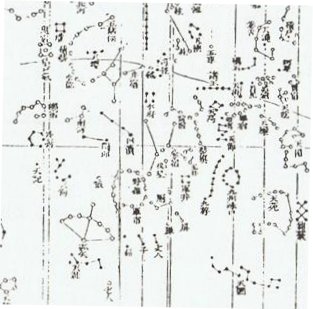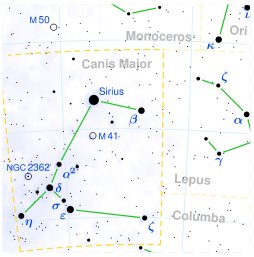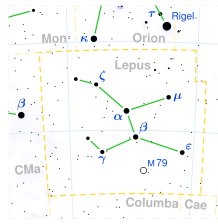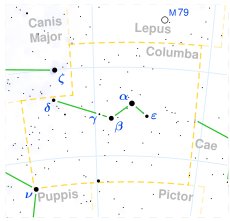In China, we have seen, there is a great hole formed by 13 (?) stars located between 'Bow and Arrow' and Orion:
A smaller hole with 9 stars are to the right of Orion. We can also see that the arrow seems to be aiming at the top of a straight vertical 'pole' with 8 stars, reminding us of how Satit according to the round Dendera zodiac apparently is aiming at the perching bird on the 'pillar' beyond the Sothis cow. In Allen we can find the constellation Lepus (the Hare) below and slightly to the left of Orion. The stars in this region do not suggest any obvious circular form as far as I can see (the pictures below are from Wikipedia):
Maybe the Chinese 'great hole' constellation is a combination of stars in Canis Major (including Sirius) and Lepus. Allen associates Lepus (an ancient constellation) with the moon and he takes the opportunity to diverge into how the patterns on the moon were perceived in different times and places. Considering how Lepus comes below Orion I think the association to the Moon is quite in place - next phase beyond the blind Orion ought to be a season of Moon, especially if it is located further down. For our present purposes a few comments from Allen are noteworthy: "Hewitt says that in earliest Egyptian astronomy Lepus was the Boat of Osiris, the great god of that country, identified with Orion. The Chinese knew it as Tsih, a Shed." "Brown writes of the often discussed comparative location of Lepus and Orion: The problem which perplexed the ancients, why the Mighty-hunter and his Dog should pursue the most timid of creature, is solved when we recognize that Orion was originally a solar type, and that the Hare is almost universally a lunar type; and mentions the very singular connection between this creature and the moon shown on Euphratean cylinders, Syrian agate seals, Chinese coins, the Moon-cakes of Central Asia, and in the legends of widely separated nations and savage tribes." "Other near-by-stars [than α], presumably in Lepus, were the Chinese Kuen Tsing, an Army Well, and Ping Sing, the Star Screen." We can guess it was this Army Well which inspired the picture of a 'great hole' in the Chinese star map above. A Star Screen is for hiding, of special interest for such 'lapwing' types as hares. The idea of a screen is not far from the idea of a 'black cloth'. A bird with a broken wing (like the illusory one of the lapwing, rechyt) is found among the stars, number 529 in Makemson: "529. Rehua; an important Maori star and an influential god, elder brother of Tane dwelling in the tenth heaven. Rehua has been variously identified with Jupiter by Tregear, with Sirius by Stowell, and with Antares by Best, and there can be no doubt that the name was applied to different objects in various sections of New Zealand. And old native declared: 'Rehua is a star, a bird with two wings; one wing is broken. Under the unbroken wing is Te Waa-o-Tamarereti (the Canoe of Tamarereti is the Tail of Scorpius in this instance). When Rehua mates with his wife Pekehawani (a star close to Antares) the ocean is windless and motionless.' Antares, visible in the morning sky of December-January, came to stand for summer heat; hence the saying, 'Rehua cooks (ripens) all fruit'. The generally accepted version of the Rehua myth, according to Best, is that Rehua had two wives, the stars on either side of Antares. One was Ruhi-te-rangi or Pekehawani, the personification of summer lanaguor (ruhi), the other Whaka-onge-kai, She-who-makes-food-scarce before the new crops can be harvested ..." Was it pure coincidence that Rehua became number 529? This number can be 'translated' as 5 (fire) and 29 (darkness). By the star's position in between his 2 wives it resembles Alnilam (in the center of the Belt of Orion). Another myth is using this pattern too, and - significantly - the story includes a stone which covered a hole. |



